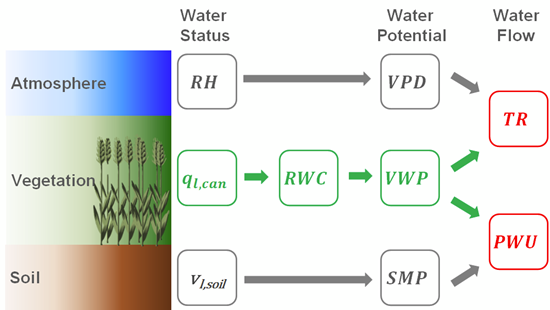LAFI
Land-Atmosphere Feedback Initiative (LAFI) – Remote sensing of vegetation canopy properties: States & spatio-temporal dynamics
Project start: 01.04.2024
Duration: 4 years
Funding: DFG
Project Lead: Dr. Thomas Jagdhuber
Involved scientists: Florian Hellwig
Collaborative partners: University of Hohenheim, German Weather Service (DWD), Technical University of Dresden, Luxembourg Institute of Science and Technology, University of Bayreuth, Ludwig Maximilian University of Munich, Karlsruhe Institute of Technology, University of Tübingen
Description
The quality of weather forecasts, seasonal simulations, and climate projections depends critically on the adequate representation of land-atmosphere (L-A) feedbacks. These feedbacks are the result of a highly complex network of processes and variables related to the exchange of momentum, energy, and mass. Significant challenges persist in understanding processes and feedbacks, which this initiative will address. The Land-Atmosphere Feedback Initiative (LAFI) is an interdisciplinary consortium of researchers from atmospheric, agricultural, and soil sciences as well as from bio-geo-physics, hydrology, and neuroinformatics proposing a novel combination of advanced research methods. The overarching goal of LAFI is to understand and quantify L-A feedbacks via unique synergistic observations and model simulations from the micro-gamma (approx. 2 m) to the meso-gamma (approx. 2 km) scales across diurnal to seasonal time scales. LAFI consists of a network of closely intertwined projects addressing six research challenges formulated as objectives and hypotheses on 1) alternative similarity theories, 2) the impact of land-surface heterogeneity, 3) partitioning evapotranspiration, 4) understanding entrainment, 5) synergistic characterization of L-A feedback, and 6) droughts or heatwaves potentially investigated by ad-hoc field observations. Collaboration across the twelve projects will be fostered by three Cross Cutting Working Groups on Deep Learning, Sensor Synergy and Upscaling, as well as the LAFI Multi-model Experiment. Our research highlights include: A) The observation of L-A system processes and feedbacks at two sites dominated by agricultural land use: I) The Land-Atmosphere Feedback Observatory (LAFO) at the University of Hohenheim enhanced by a worldwide-unparalleled synergy of instruments, e.g., combining for the first time measurements of water stable isotopes, fiber-optic distributed temperature sensors, and scanning lidar systems, II) the Meteorological Observatory Lindenberg-Richard Aßmann Observatory (MOL-RAO) of the German Meteorological Service providing a long-term data set for studying the statistics of droughts and heatwaves. B) Under-studied and poorly understood processes in the L-A system, C) Improvement and application of L-A system models down to the large eddy scales with advanced representation of vegetation and water stable isotopes. D) Application of deep learning (DL) methods for identifying key and potentially novel factors in process descriptions. Based on this combination of research components, we will characterize the multi-dimensional phase space of L-A system variables with various process-based metrics over an entire vegetation period in order to reach the overarching LAFI goal. Fueled by the tightly interwoven collaborative research, the LAFI research unit will gain crucial new insights into L-A feedbacks and processes for the characterization of coupling strengths over agricultural regions in central Europe.

Especially the influence of vegetation canopy properties and their spatio-temporal dynamics on feedbacks between the land surface and the atmosphere (i.e., temperature, precipitation, humidity, atmospheric boundary layer properties) are not conclusively understood. One major reason for this is that high-resolution observational data products (c.f. on vegetation canopy moisture) are not available yet at high spatial resolution (decameter scale) and on multi-year time scales: neither from remote sensing nor from models. In addition, land surface heterogeneities (e.g. variety in vegetation cover) can have significant impacts on feedback processes between canopy and proximate atmosphere, but their representation in models is not sufficient at high spatial resolutions. To bridge these gaps, remote-sensing based products are being developed to account for some of the multiple varying vegetation conditions. In that sense, the idea of Project 2 is to monitor a range of vegetation canopy properties, encompassing water content pools (e.g., soil and vegetation moisture) and fluxes (e.g., evapotranspiration) at both field (link to in situ data) and regional (link to earth system model data) scales. The approach takes advantage of the potential synergies among optical, passive and active microwave sensors, which offer complementary information to transform remote sensing signals (e.g., microwave attenuation) into biophysical variables (e.g., gravimetric vegetation moisture, evapotranspiration, or vegetation structure and density). These unique and unprecedented datasets of satellite-based multi-sensor remote sensing will be fed into land-atmosphere (L-A) models to determine and analyze boundary layer properties and L-A feedbacks. All these land surface variables can synergistically contribute to understanding the link between soil, vegetation and the atmospheric boundary layer processes and to initialize L-A models. P2 directly focuses on the high-resolution (decameter-scale) determination of states and spatio-temporal dynamics of the moisture, temperature and topography of the vegetation canopy to track moisture and temperature distributions for assessing transpiration and the shape as well as 3D-dynamics of the atmospheric roughness sublayer. This is achieved by blending of multi-sensor remote sensing observations (e.g. Copernicus Sentinel satellites & space-borne LiDARs). Spatio-temporally dynamic information of these vegetation variables will be prepared for integration into the fleet of land-atmosphere models of LAFI for assessing boundary layer properties and understanding of L-A feedbacks.
